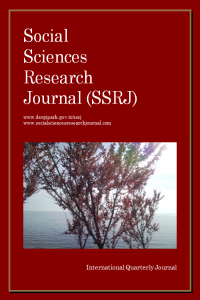Investigating Fresh Fruit and Vegetables Losses at Contemporary Food Retailers
distribution, food retailing, food loss, consumer
Investigating Fresh Fruit and Vegetables Losses at Contemporary Food Retailers
distribution, food retailing, food loss, consumer,
___
- Buzby J. C., J. Hyman, H. Stewart, & H. F. Wells (2011). The Value of Retail- and Consumer-Level Fruit and Vegetable Losses in the United States. The Journal of Consumer Affairs, 492–515
- Buzby, J., Wells, H., & Hyman, J. (2014). The Estimated Amount, Value, and Calories of Postharvest Food Losses at the Retail and Consumer Levels in the United States. Economic Research Service. USDA, USA.
- Buzby J. C., J. T. Bentley, B. Padera, C. Ammon & J. Campuzano (2015). Estimated Fresh Produce Shrink and Food Loss in U.S. Supermarkets. Agriculture, 5, 626-648
- Gustavsson, J., Cederberg, C., Sonesson, U., & Andreas. (2013). The methodology of the FAO study: ''Global Food Losses and Food Waste''. Düsseldorf, Germany.
- Hailu G. & B. Derbew (2015). Extent, Causes and Reduction Strategies of Postharvest Losses of Fresh Fruits and Vegetables. Journal of Biology, Agriculture and Healthcare, 5, 5, 49-65
- Kader, A.A. (2013) Postharvest Technology of Horticultural Crops—An Overview from Farm to Fork. Ethiopian Journal of Science and Technology, 1, 1-8.
- Kitinoja L. & A. A. Kader (2015). Measuring postharvest losses of fresh fruits and vegetables in developing countries. The Postharvest Education Foundation ISBN 978-1-62027-006-6.
- McKenzie T.J., L. Singh-Peterson & S. J. R. Underhill (2017) Quantifying Postharvest Loss and the Implication of Market-Based Decisions: A Case Study of Two Commercial Domestic Tomato Supply Chains in Queensland, Australia. Horticulturae, 3, 44
- Oral, Z. (2015). Food Waste Prevention and Practice For Turkey and World. Ankara.
- Papargyropoulou, E., Lozano, R., Steinberger, J., Wright, N., & Ujang, Z. b. (2014). The food waste hierarchy as a framework for the management of food surplus and food waste. Journal of Cleaner Production, 76, 106-115.
- Rolle, R. (2006). Improving Postharvest Management And Marketing In The Asia-Pacific Region: Issues And Challenges. Postharvest Management of Fruit, 25-31.
- Sivakumar, D., Jiang, Y., & Yahia, E. (2011). Maintaining mango fruit quality during the export chain. Food Research International, 44, 1254-1263
- Stuart, T. (2009). Waste: Uncovering the Global Food Scandal. W. W. Norton & Company, New York, USA.
- Turkish Statistical Institute. (2018). Turkish Statistical Institute. Accessed on 2018 March, Turkish Statistical Institute Web Site: www.tuik.gov.tr/PdfGetir.do?id=24581
- Yayın Aralığı: Yılda 4 Sayı
- Yayıncı: Denta Florya ADSM Limited Company
Okul Öncesi Öğretmen Adaylarının Darbe Kavramına İlişkin Metaforik Algıları
Üniversite Gençlerinin Duygu Yönetimi Becerileri Üzerine Bir Araştırma
Gümüş Sörfçüler: Yaşlıların İnternet Hakkındaki görüşleri, deneyimleri ve düşünceleri
Dilek ALTAŞ, Selay Giray Yakut, Özlem YORULMAZ
Temel Finansal Tablolar Analizinin Etkin Bir Vergi Denetimi Açısından Önemi
H.tezcan UYSAL, M. Güçlü KAYHAN
Türk Bankacılık Sektöründe Cam Tavan Sorunu
İstanbul’daki Beş Yıldızlı Otel İşletmelerinde Müşteri Beklentilerine Yönelik Sunulan Makro Trendler
Investigating Fresh Fruit and Vegetables Losses at Contemporary Food Retailers
Yoksulluğun Giderilmesinde Sosyal Yardım Alan Yetişkinlerin Meslek Eğitimi
